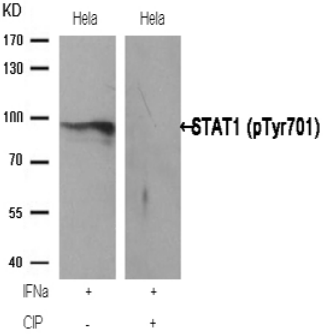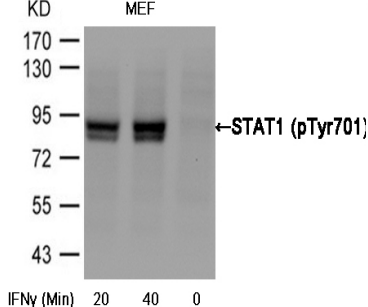Anti-STAT1 (phospho-Tyr701) Antibody (43044)
Data
 Immunohistochemistry: Detection of STAT1 (phosphoTyr701) in paraffin-embedded
human breast carcinoma tissue.
Immunohistochemistry: Detection of STAT1 (phosphoTyr701) in paraffin-embedded
human breast carcinoma tissue. - -
- -
Antibody DetailsProduct DetailsReactivity Species Human ⋅ Mouse Host Species Rabbit Immunogen Peptide sequence that includes phosphorylation site of tyrosine 701 (T-G-Y(p)-I-K) derived from human STAT1 and conjugated to KLH. Product Concentration 1.0 mg/ml Formulation PBS (without Mg2 and Ca2 ), pH 7.4, 150mM NaCl, 0.02% sodium azide and 50% glycerol. State of Matter Liquid Product Preparation Affinity-purified on phosphopeptide; non-phosphopeptidereactive antibodies were removed by chromatography on non-phosphorylated peptide Storage and Handling This antibody is stable for at least one (1) year at -20°C. Country of Origin USA Shipping Next Day 2-8°C Applications and Recommended Usage? Quality Tested by Leinco Immunoblotting: use at dilution of 1:500-1:1,000. A band of ~91kDa is detected.
Immunohistochemistry: use at dilution of 1:50-1:100. These are recommended working dilutions. End user should determine optimal dilutions for their applications. Each investigator should determine their own optimal working dilution for specific applications. See directions on lot specific datasheets, as information may periodically change. DescriptionSpecificity Rabbit Polyclonal Antibody specific to STAT1 (phospho-Tyr701) Background Signal transducers and activators of transcription (STATs) are transcription factors that play important roles in signaling pathways induced by many different cytokines and growth factors that regulate cell growth and differentiation, the immune response, antiviral activity, and homeostasis. Their activation and mechanisms of action are examples of direct signaling to the nucleus by extracellular polypeptide ligands without the involvement of second messengers, tyrosine phosphorylation of transcription factors, or transcription factors that make direct contact with membrane-bound receptors and DNA. Since the discovery of STAT 1 and 2, the family has been expanded to seven members. Two alternatively spliced isoforms of STAT1 (p84 and p91) have been described. Antigen DetailsFunction Signal transducer and transcription activator that mediates cellular responses to interferons (IFNs), cytokine KITLG/SCF and other cytokines and other growth factors. Following type I IFN (IFN-alpha and IFN-beta) binding to cell surface receptors, signaling via protein kinases leads to activation of Jak kinases (TYK2 and JAK1) and to tyrosine phosphorylation of STAT1 and STAT2. The phosphorylated STATs dimerize and associate with ISGF3G/IRF-9 to form a complex termed ISGF3 transcription factor, that enters the nucleus (PubMed:28753426). ISGF3 binds to the IFN stimulated response element (ISRE) to activate the transcription of IFN-stimulated genes (ISG), which drive the cell in an antiviral state. In response to type II IFN (IFN-gamma), STAT1 is tyrosine- and serine-phosphorylated (PubMed:26479788). It then forms a homodimer termed IFN-gamma-activated factor (GAF), migrates into the nucleus and binds to the IFN gamma activated sequence (GAS) to drive the expression of the target genes, inducing a cellular antiviral state. BPubMed:12764129, PubMed:12855578, PubMed:15322115, PubMed:19088846, PubMed:26479788, PubMed:28753426, PubMed:8156998, PubMed:9724754}. NCBI Gene Bank ID UniProt.org Research Area Phosphospecific Antibodies References & CitationsTechnical Protocols |




